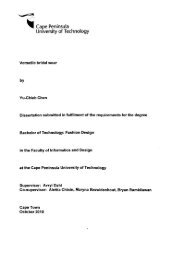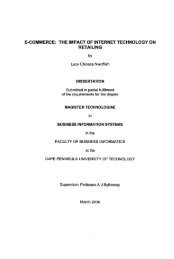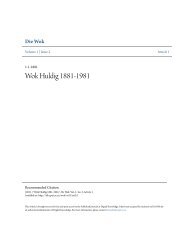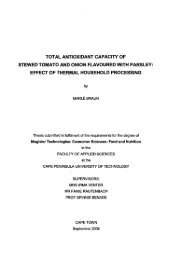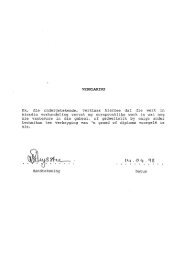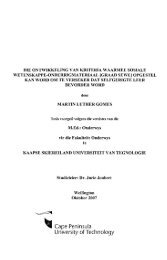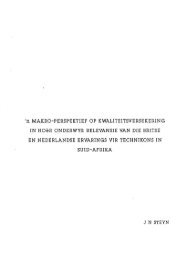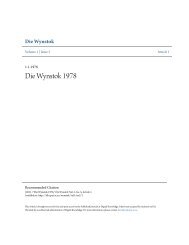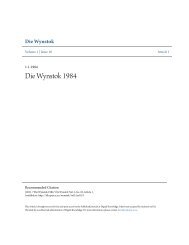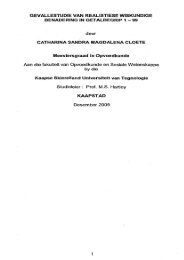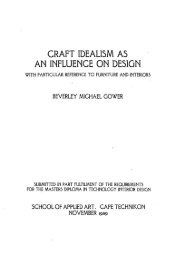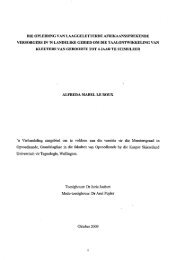the effect of the particle size distribution on non-newtonian turbulent ...
the effect of the particle size distribution on non-newtonian turbulent ...
the effect of the particle size distribution on non-newtonian turbulent ...
You also want an ePaper? Increase the reach of your titles
YUMPU automatically turns print PDFs into web optimized ePapers that Google loves.
Appendix B C<strong>on</strong>ference Paper B.Il<br />
through c<strong>on</strong>ducting clear water pipeline tests. Mean velocity and wall shear stress were<br />
measured for velocities over <str<strong>on</strong>g>the</str<strong>on</strong>g> test range and roughness was determined using <str<strong>on</strong>g>the</str<strong>on</strong>g><br />
Colebrook / White (1939) equati<strong>on</strong>.<br />
3.3 Material Used<br />
The solids material used for testing purposes was kaolin clay and sand. Tests were<br />
c<strong>on</strong>ducted using kaolin clay and <str<strong>on</strong>g>the</str<strong>on</strong>g>n a mixture <str<strong>on</strong>g>of</str<strong>on</strong>g> kaolin clay and No. 2 Foundry Sand<br />
from C<strong>on</strong>sol at varying c<strong>on</strong>centrati<strong>on</strong>s.<br />
- Kaolin Clay<br />
Kaolin clay was obtained from <str<strong>on</strong>g>the</str<strong>on</strong>g> Serina Kaolin (Pty) Ltd which is currently mining a<br />
kaolin deposit at Brakkeklo<str<strong>on</strong>g>of</str<strong>on</strong>g>, Fish Reek, Cape Town, South Africa. The kaolin was<br />
delivered in <str<strong>on</strong>g>the</str<strong>on</strong>g> form <str<strong>on</strong>g>of</str<strong>on</strong>g> pellets and filter cakes. To obtain a homogenous slurry <str<strong>on</strong>g>the</str<strong>on</strong>g><br />
pellets or filter cake was thoroughly mixed with water using a recirculating pipe after<br />
<str<strong>on</strong>g>the</str<strong>on</strong>g> pump back into <str<strong>on</strong>g>the</str<strong>on</strong>g> hopper before circulating <str<strong>on</strong>g>the</str<strong>on</strong>g> slurry through <str<strong>on</strong>g>the</str<strong>on</strong>g> pipelines.<br />
- Sand<br />
Sand was obtained from C<strong>on</strong>sol in 25kg bags called No. 2 Foundry Sand. The <str<strong>on</strong>g>particle</str<strong>on</strong>g><br />
<str<strong>on</strong>g>size</str<strong>on</strong>g> <str<strong>on</strong>g>of</str<strong>on</strong>g> <str<strong>on</strong>g>the</str<strong>on</strong>g> sand was between 75 and 350 I'm.<br />
3.3.1 Mixtures <str<strong>on</strong>g>of</str<strong>on</strong>g> Kaolin Clay and Sand<br />
The sand used was found to form a settling slurry with water. In order to obtain a<br />
homogeneous slurry, kaolin clay was used as a suspending agent for <str<strong>on</strong>g>the</str<strong>on</strong>g> sand. Tests<br />
were <str<strong>on</strong>g>the</str<strong>on</strong>g>refore c<strong>on</strong>ducted to determine <str<strong>on</strong>g>the</str<strong>on</strong>g> amount <str<strong>on</strong>g>of</str<strong>on</strong>g> kaolin clay needed to suspend <str<strong>on</strong>g>the</str<strong>on</strong>g><br />
sand. It was found that kaolin clay at a c<strong>on</strong>centrati<strong>on</strong> <str<strong>on</strong>g>of</str<strong>on</strong>g>at least Cv = 5% was required.<br />
3.4 Particle Size Distributi<strong>on</strong><br />
The <str<strong>on</strong>g>particle</str<strong>on</strong>g> <str<strong>on</strong>g>size</str<strong>on</strong>g> <str<strong>on</strong>g>distributi<strong>on</strong></str<strong>on</strong>g> <str<strong>on</strong>g>of</str<strong>on</strong>g><str<strong>on</strong>g>the</str<strong>on</strong>g> kaolin clay/sand mixture was obtained by combining<br />
<str<strong>on</strong>g>the</str<strong>on</strong>g> PSD <str<strong>on</strong>g>of</str<strong>on</strong>g><str<strong>on</strong>g>the</str<strong>on</strong>g> kaolin clay (determined using a Malvern 2600/3600 Particle Sizer VF.6)<br />
and <str<strong>on</strong>g>the</str<strong>on</strong>g> PSD <str<strong>on</strong>g>of</str<strong>on</strong>g> <str<strong>on</strong>g>the</str<strong>on</strong>g> sand determined through sieving. The dS5 was <str<strong>on</strong>g>the</str<strong>on</strong>g>n obtained from <str<strong>on</strong>g>the</str<strong>on</strong>g><br />
combined PSD's as shown below in Figure 1.<br />
4. ANALYSIS & RESULTS<br />
The measured variables <str<strong>on</strong>g>of</str<strong>on</strong>g> head loss and velocity were used to plot pseudo-shear<br />
diagrams ie wall shear stress vs pseudo-shear rate. A typical pseudo-shear diagram is<br />
shown in Figure 2 and <str<strong>on</strong>g>the</str<strong>on</strong>g> improvement obtained using <str<strong>on</strong>g>the</str<strong>on</strong>g> new model, is clearly visible,<br />
as opposed to <str<strong>on</strong>g>the</str<strong>on</strong>g> o<str<strong>on</strong>g>the</str<strong>on</strong>g>r <str<strong>on</strong>g>the</str<strong>on</strong>g>oretical models.



